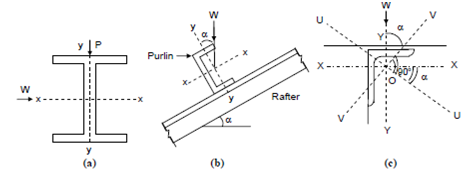Examples of Biaxial Bending:
We are giving here a few examples of biaxial bending met with in actual practice. You will learn to solve numerical examples relating to such problems in the subsequent sections.
(a) Figure (a) shows an I-section girder subjected to a vertical loading, P, in the vertical plane producing a bending moment about the horizontal plane (the horizontal X-X axis). It may at the same time be subjected to a horizontal wind load, W, causing a bending moment about the vertical axis YY. Therefore, a biaxial bending is produced in the section.
(b) The rafter of a roof truss shown in Figure (b) is inclined at an angle α with the horizontal. A purlin, that is a channel section, will therefore have its principal axis X-X inclined at an angle α with horizontal. When a vertical load, W, is applied to the purlin, the bending will be in a plane inclined at as angle α with the principal axis YY.

Figure
We may resolve W along the directions of the principal axes : W cos α along YY and W sin α along XX. The former will cause a bending about XX axis, and the latter about the YY axis of the channel section, and the bending becomes biaxial.
(c) In the angle section shown in Figure (c), the axes XX and YY, which are parallel to the legs are not the principal axes, as they are not the axes of symmetry for the section. The principal axes are UU and VV inclined at α with XX and YY respectively. Hence, a load W, which acts parallel to a leg along the axis YY causes an unsymmetrical bending in the section. It has to be resolved along the two principal directions and the case has to be treated as that of biaxial bending.